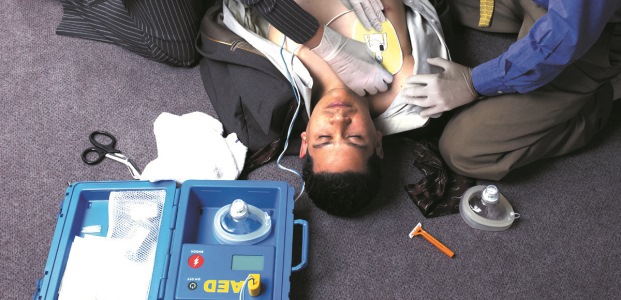
'Anyone Can Help Save a Life'
"Knowing someone on hand is first aid trained should an event occurs reduces the stress level of all the employees and makes them feel safer."
Robert "Bo" Hanna, an experienced first aid and CPR trainer, explains why this training should be part of every workplace's safety program and why having trained employees makes a workplace safer and more productive.
What is your background in first aid and CPR training?
I have been training people in first aid and CPR for many years. As an instructor for the United States Air Force, I instructed teams in first aid and CPR, which they call self-aid and buddy care. While employed as a firefighter for the Boeing Aircraft Company for 25 years, I instructed the department's emergency medical technician recertification training program. I was also an instructor for American Heart Association first aid and CPR training for Boeing's aircraft manufacturing employees throughout Washington State. Currently, I am a Training Center Faculty for Cascade Training Center in Seattle, Washington, and have been for a number of years. With Cascade, I have had the opportunity to instruct more than 100 courses for at least the last five years.
Why do you think it's important for workplaces to include first aid and CPR in their safety programs?
It's important for workplaces to include first aid and CPR in their safety programs because these skills help save lives.
The immediate treatment of an injured or sick employee having a heart attack can make the difference between life and death. Not only do minutes count for injured or sick employees, but having trained first aid personnel ready provides peace of mind to the rest of the team. Knowing someone on hand is first aid trained should an event occurs reduces the stress level of all the employees and makes them feel safer. Trained personnel will attend to the sick or injured employee and control the scene. This will allow the remaining employees in the area to return to work and be productive. It has also been found that first aid trained personnel pay more attention to their surroundings and will be more likely to identify and correct unsafe conditions in the work area. Training helps prevent issues as well as manage events, should they occur.
What are some tips for safety and health professionals looking for a first aid and CPR program to implement?
The program must provide basic and simple instructions. First aid and CPR are not the employee's main responsibilities. The curriculum needs to be basic enough that the employee will remember a few simple steps for each or any emergency that occurs. The course must build psychomotor memory so the employee does not need to think about what needs to be done, they just react. Practicing the basic skills within the course is essential.
When you've trained people, what are the most interesting questions or comments you’ve received?
I have heard from many returning students that when an event occurred, their actions were nearly automatic. They didn't try to remember what they were told to do, they just did what made sense. After the event was over and they looked back on it, they had performed as they were instructed in the course. Comments like that are always gratifying to hear.
Sometimes people ask, "Is it going to hurt somebody if I do CPR on them?" That's a very common concern. I tell them that if the person is not breathing, the only thing that's going to hurt the person is you not doing something. Any action is better than no action.
What are some things people are shocked to learn?
My students are quite often surprised that just a little knowledge can make such a grand difference in the outcome of an event.
Have you ever had to help someone with first aid and CPR? What was that like?
I have been in the first aid line of work since I became a volunteer firefighter at the age of 16. I have had events that turned out great, and I have had events I wish I could forget. You celebrate the ones that go well and you learn from the one that don’t go so well.
I had the privilege of performing CPR on my father. When he left for the hospital, he had a pulse and was breathing. He later died at the hospital, but I knew I had done everything I could do to give him the opportunity to live.
What are some misconceptions people have about CPR and first aid?
A common misconception is that first aid is difficult and you need an in-depth amount of learning experience to help someone.
Why are people afraid to learn CPR and first aid?
They believe first aid is difficult and it is hard to be able to help someone in an emergency. Many students believe they have to be able to understand anatomy and physiology. They think they need to be big and strong. Really, anyone can help save a life. And everyone should know how.
How do you reassure people about learning CPR and first aid?
First of all, I make sure they understand that while I may not be the smartest person around, I was able to learn and use first aid and CPR very successfully. I let them know they have been performing first aid their entire life on their self and family members.
This article originally appeared in the April 2015 issue of Occupational Health & Safety.